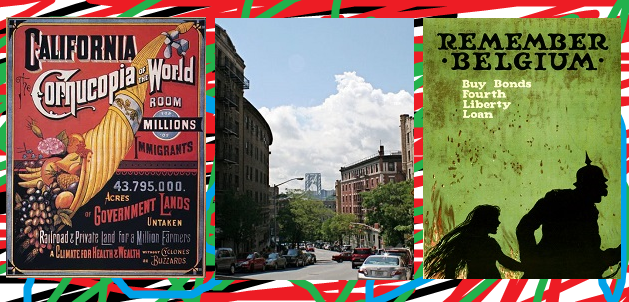
Asaavedra32, Library of Congress
At left and right, examples of propaganda’s range of uses. In the center, a view of Inwood today.
It was beginning to drizzle, the first time I walked through the park to Manhattan’s only salt marsh. From its southern entrance, the paths quickly branch into several narrow trails. Despite the nagging feeling that I might be going the wrong way, I kept walking, excitedly examining mushrooms, berries, trees and common weeds–testing my knowledge. After quickly consulting a large map, I decided to take a short trail down the hill where I passed someone’s camp.
At the bottom I reached Shorakkopoch Rock where the Dutch bought Manhattan from the Lenape for trinkets. Nearby are the marsh, baseball fields, and boathouse.
Mulling over my walk and the history of this site, I contemplate how individuals and their compelling ideas have shaped this space over time.
For social scientist W.E.B. Du Bois, propaganda was a vital strategy to affect change, one that he charged black artists with creating, to uplift their race.
To change whites’ “attitudes and habits thus built up” by “inherited customs and of those irrational and partly subconscious actions” required “a long patient, well-planned and persistent campaign of propaganda.”
Given the diverse purposes of propaganda in history and at present to mislead, instill fear, or defend interests, how do artists consider wielding this device? How do artists use techniques of persuasion and propaganda in their artwork? This is the question I ask New York and uptown artists to consider for Northern Manhattan Arts Alliance’s 5th public art initiative being installed in Inwood Hill Park this fall.
For more information on how to submit a proposal for this public art opportunity, please visit www.nomaanyc.org. Applications are due August 24, 2018.
Stephanie Lindquist is the director of Bronx Art Space.
City Limits’ reporting on the intersection of art and policy is supported by the Laurie M. Tisch Illumination Fund. City Limits is solely responsible for all content.
CityViews: A Call for Art Asks, Can Propaganda Promote the Public Good?
By Stephanie Lindquist.
Asaavedra32, Library of Congress
At left and right, examples of propaganda’s range of uses. In the center, a view of Inwood today.
It was beginning to drizzle, the first time I walked through the park to Manhattan’s only salt marsh. From its southern entrance, the paths quickly branch into several narrow trails. Despite the nagging feeling that I might be going the wrong way, I kept walking, excitedly examining mushrooms, berries, trees and common weeds–testing my knowledge. After quickly consulting a large map, I decided to take a short trail down the hill where I passed someone’s camp.
At the bottom I reached Shorakkopoch Rock where the Dutch bought Manhattan from the Lenape for trinkets. Nearby are the marsh, baseball fields, and boathouse.
Mulling over my walk and the history of this site, I contemplate how individuals and their compelling ideas have shaped this space over time.
For social scientist W.E.B. Du Bois, propaganda was a vital strategy to affect change, one that he charged black artists with creating, to uplift their race.
To change whites’ “attitudes and habits thus built up” by “inherited customs and of those irrational and partly subconscious actions” required “a long patient, well-planned and persistent campaign of propaganda.”
Given the diverse purposes of propaganda in history and at present to mislead, instill fear, or defend interests, how do artists consider wielding this device? How do artists use techniques of persuasion and propaganda in their artwork? This is the question I ask New York and uptown artists to consider for Northern Manhattan Arts Alliance’s 5th public art initiative being installed in Inwood Hill Park this fall.
For more information on how to submit a proposal for this public art opportunity, please visit www.nomaanyc.org. Applications are due August 24, 2018.
Stephanie Lindquist is the director of Bronx Art Space.
City Limits’ reporting on the intersection of art and policy is supported by the Laurie M. Tisch Illumination Fund. City Limits is solely responsible for all content.
Latest articles
Opinion: Competent Grads Need Emotional Strength, Too
By David Adams and Rita Joseph
PODCAST: ¿Qué se sabe de la empresa que gestiona el centro de detención de inmigrantes de Guantánamo?
By Daniel Parra
NYC Housing Calendar, March 3-10
By Jeanmarie Evelly
Opinion: Why Latinx Mental Health Can’t Wait in New York City
By Valentina Cuellar Laguna
City to End 28-Day Hotel Stays for Immigrant Families with Children
By Daniel Parra
more stories:
Opinion: Competent Grads Need Emotional Strength, Too
By David Adams and Rita Joseph
Opinion: Why Latinx Mental Health Can’t Wait in New York City
By Valentina Cuellar Laguna
Opinion: Transforming Systems of Harm into Systems of Care for Black Families
By Zainab Akbar, Emma S. Ketteringham, Lauren Shapiro and Christine Waer
Add Unit